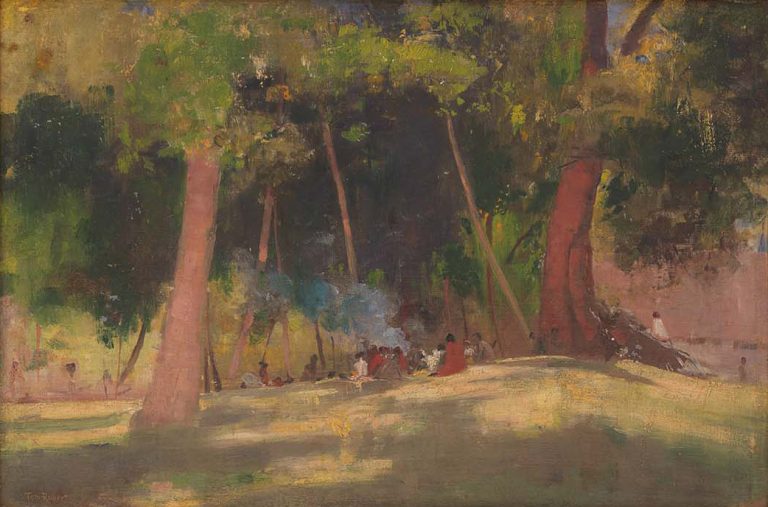We acknowledge the Traditional Owners of the land on which the Queensland Art Gallery | Gallery of Modern Art stands and recognise the creative contribution First Australians make to the art and culture of this country.

Tom Roberts / Australia 1856–1931 / (Indigenous gathering, Far North Queensland) 1892 / Oil on canvas / 37.7 x 55.9cm / Gift of Foster’s Group Ltd through the Queensland Art Gallery Foundation 2006 / Collection: Queensland Art Gallery | Gallery of Modern Art
Tom Roberts(Indigenous gathering, Far North Queensland) 1892
On Display: QAG, Gallery 10
On 28 July 1892, Tom Roberts set sail from Sydney as acting mate on board the 15-tonne ketch Jessie, headed for far north Queensland. The journey appealed to Roberts’s interest in anthropology and, during the trip, he painted several portrait studies of Indigenous people, with a degree of sensitivity that was uncommon for the time.
This painting of a group of Indigenous people in their country was most likely painted on Mer (Murray Island) in the Torres Strait. Mer is famous for being the birthplace of Eddie Koiki Mabo (1936–92), who paved the way for the recognition of native title in Australian law.
Painting en plein air, Tom Roberts depicted Australia’s particular qualities of light, heat, space and distance.
Tom Roberts was born in England in 1856. Following the death of his father, the family travelled to Melbourne in 1869 to live with relatives. Roberts worked as a photographer’s assistant, studying drawing and painting in the evenings. Returning to London in 1881, he studied at the Royal Academy of Arts.
In 1883, he toured Spain with Australian artist John Peter Russell. Here, he met artists Laureano Barrau and Ramon Casas, who introduced him to Impressionism and painting en plein air. Roberts also absorbed the progressive influences of French painter Jules Bastien-Lepage and American painter James Abbott McNeill Whistler. His experiences abroad, including his familiarisation with the French Barbizon School and Impressionism, greatly influenced his art.
Roberts pioneered plein-air painting in Australia when he returned in 1885. With Frederick McCubbin and Louis Abrahams, he founded the first of the artists’ camps at Box Hill, Victoria. These artists and others would become known as the Heidelberg School, the first truly Australian art movement.
In 1889, with Charles Conder and Arthur Streeton, Roberts organised the landmark ‘9 by 5 Impression Exhibition’, held at Buxton’s Rooms in Swanston Street, Melbourne. This popular exhibition was the first major exhibition of impressionist paintings in Australia.
Discussion Questions
1. Imagine you could step into Roberts’s painting. Describe how your five senses would be engaged.
2. How do the elements of shape, form, colour and texture influence your interpretation of this painting?
Classroom Activities
What do you know about Mer (Murray Island)? Research the island’s settlement, history and culture. Discuss the results of your research with your classmates. Create an artwork that reflects your findings.